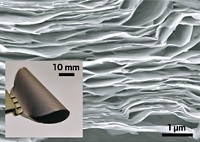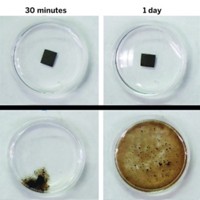Advertisement
Grab your lab coat. Let's get started
Welcome!
Welcome!
Create an account below to get 6 C&EN articles per month, receive newsletters and more - all free.
It seems this is your first time logging in online. Please enter the following information to continue.
As an ACS member you automatically get access to this site. All we need is few more details to create your reading experience.
Not you? Sign in with a different account.
Not you? Sign in with a different account.
ERROR 1
ERROR 1
ERROR 2
ERROR 2
ERROR 2
ERROR 2
ERROR 2
Password and Confirm password must match.
If you have an ACS member number, please enter it here so we can link this account to your membership. (optional)
ERROR 2
ACS values your privacy. By submitting your information, you are gaining access to C&EN and subscribing to our weekly newsletter. We use the information you provide to make your reading experience better, and we will never sell your data to third party members.
Water
Water flies through fluorine-lined channels
Chemical interactions break up water clusters, leading to ultrafast transport
by Bethany Halford
May 12, 2022

Inspired by the water-repelling properties of the fluoropolymer PTFE (better known by its trade name, Teflon), chemists have created nanochannels lined with fluorine atoms that transport water at ultrafast speeds. These channels, which also exclude negatively-charged chloride ions, could guide strategies for improving desalination materials.
Anyone who has ridden down a waterslide will tell you that aqueous modes of transport are fast. But on the molecular scale, water’s tendency to form clusters and hydrogen bonds can make it travel sluggishly through tiny channels. Cells speed up water’s transport using aquaporins—protein channels with hydrophobic interiors that repel water and break up those clusters. Similarly, water can travel quickly through carbon nanotubes.
A team led by the University of Tokyo’s Yoshimitsu Itoh, Kohei Sato, and Takuzo Aida, wondered what would happen if they created nanochannels with a lining that resembled Teflon’s fluorinated surface. The chemists synthesized a series of oligoamide nanorings with fluorine atoms lining the rings’ interior. These rings stack to make supramolecular channels in phospholipid bilayer membranes. When the chemists tested nanochannels with the smallest diameter—just 0.9 nm—they found that water travels through the channels at speeds that are hundreds of times faster than water transport through either aquaporins or carbon nanotubes (Science 2022, DOI: 10.1126/science.abd0966). Like the aquaporins’ hydrophobic interiors, the nanochannels’ fluorinated lining breaks up water clusters. The electrostatically negative surface also repels chloride ions, preventing salt from moving through the channels.
This result is startling, says Aleksandr Noy, a scientist at the University of California, Merced, who studies water transport through carbon nanotubes. “Because these data smash our understanding of fast water transport in artificial water channels, the mechanism of this effect needs further explanation,” he says in an email. To date, most artificial water channels have forced water to travel through single-file, but Noy points out that the wider fluorine-lined channels, where water could still cluster, also have fast water permeability. “Overall, these results could suggest ways to engineer membrane pores that can enable fast flow and enhanced selectivity.”
The fluorous nanochannels described in the paper will probably not find practical applications because they’re difficult to make. Still, the researchers think that their findings hint at ways to improve existing filters used in desalination technologies. Adding fluorine, they say, could improve these materials.




Join the conversation
Contact the reporter
Submit a Letter to the Editor for publication
Engage with us on Twitter